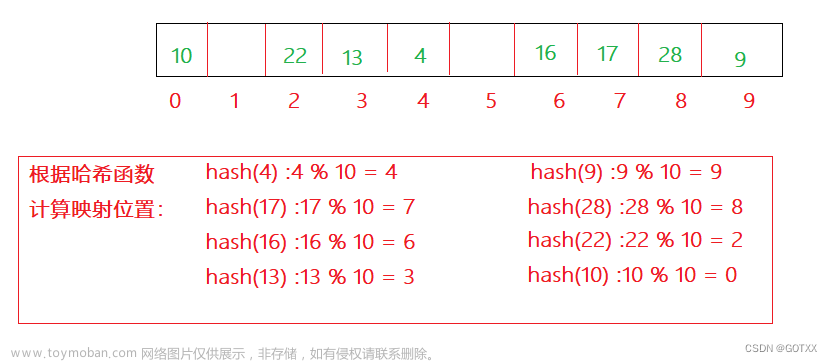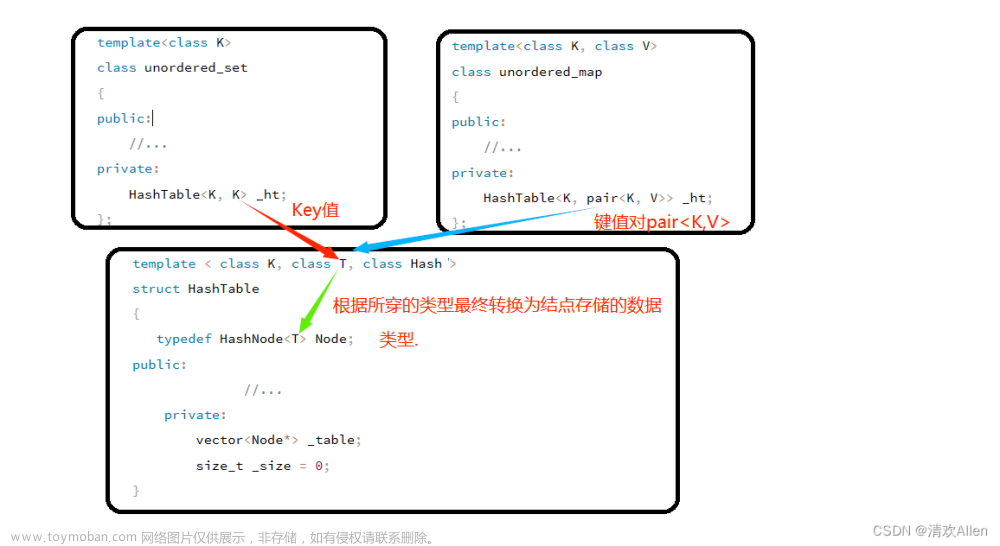🌇个人主页:平凡的小苏
📚学习格言:命运给你一个低的起点,是想看你精彩的翻盘,而不是让你自甘堕落,脚下的路虽然难走,但我还能走,比起向阳而生,我更想尝试逆风翻盘。
🛸C++专栏:C++内功修炼基地
> 家人们更新不易,你们的👍点赞👍和⭐关注⭐真的对我真重要,各位路 过的友友麻烦多多点赞关注。 欢迎你们的私信提问,感谢你们的转发! 关注我,关注我,关注我,你们将会看到更多的优质内容!!

一、unordered序列关联式容器
在C++98中,STL提供了底层为红黑树结构的一系列关联式容器,在查询时效率可达到logN,最差情况下也仅需要比较红黑树的高度次,当树中的节点非常多时,查询效率也不理想。因此在C++11中,STL又提供了4个unordered系列的关联式容器,这四个容器与红黑树结构的关联式容器使用方式基本类似,只是其底层结构不同,unordered系列容器并不是有序的。
二、unordered_map与unordered_set结构
1、unordered_map

2、unordered_set

unordered_set并不像set那样支持反向迭代器,它的迭代器底层是一个单向迭代器。 其他功能与set类似unordered_set的插入是无序的,不一定按照插入的顺序进行打印。自带去重功能。
三、红黑树与哈希的性能比较
红黑树的插入删除查找性能都是O(logN),而哈希表的插入删除查找性能理论上都是O(1),他是相对于稳定的,最差情况下都是高效的。哈希表的插入删除操作的理论上时间复杂度是常数时间的,这有个前提就是哈希表不发生数据碰撞。在发生碰撞的最坏的情况下,哈希表的插入和删除时间复杂度为O(n)。
四、哈希的底层结构
顺序结构以及平衡树中,元素关键码与其存储位置之间没有对应的关系,因此在查找一个元素时,必须要经过关键码的多次比较。顺序查找时间复杂度为O(N),平衡树中为树的高度,即O(log2N),搜索的效率取决于搜索过程中元素的比较次数。
理想的搜索方法:可以不经过任何比较,一次直接从表中得到要搜索的元素。
如果构造一种存储结构,通过某种函数(hashFunc)使元素的存储位置与它的关键码之间能够建立一一映射的关系,那么在查找时通过该函数可以很快找到该元素。
4.1常见哈希函数
-
直接定址法–(常用)
取关键字的某个线性函数为散列地址:Hash(Key) = A * Key + B
优点:简单、均匀
缺点:需要事先知道关键字的分布情况
使用场景:适合查找比较小且连续的情况 -
除留余数法–(常用)
设散列表中允许的地址数为m,取一个不大于m,但最接近或者等于m的质数p作为除数,
按照哈希函数:Hash(key) = key % p(p <= m), 将关键码转换成哈希地址
4.2哈希扩容机制

4.3闭散列
闭散列:也叫开放定址法,当发生哈希冲突时,如果哈希表未被装满,说明在哈希表中必然还有空位置,那么可以把key存放到冲突位置中的“下一个” 空位置中去。
线性探测:从发生冲突的位置开始,依次向后探测,直到寻找到下一个空位置为止。
-
插入:
通过哈希函数获取待插入元素在哈希表中的位置
如果该位置中没有元素则直接插入新元素,如果该位置中有元素发生哈希冲突,使用线性探测找到下一个空位置,插入新元素

-
删除
采用闭散列处理哈希冲突时,不能随便物理删除哈希表中已有的元素,若直接删除元素会影响其他元素的搜索。比如删除元素4,如果直接删除掉,44查找起来可能会受影响。因此线性探测采用标记的伪删除法来删除一个元素。
代码实例:
template<class K>
struct DefaultHashFunc//默认仿函数
{
size_t operator()(const K& key)
{
return (size_t)key;
}
};
template<>
struct DefaultHashFunc<std::string>//string的仿函数特化
{
size_t operator()(const std::string& str)
{
// BKDR
size_t hash = 0;
for (auto ch : str)//将哈希值转化为整型数值
{
hash *= 131;
hash += ch;
}
return hash;
}
};
namespace sqy
{
enum STATE
{
EXIST,
EMPTY,
DELETE
};
template<class K, class V>
struct HashTableData
{
std::pair<K, V> _kv;
STATE _state = EMPTY;
};
template<class K, class V, class HashFunc = DefaultHashFunc<K>>
class HashTable
{
public:
HashTable()
{
_tables.resize(10);//为了有效个数为零时计算负载因子不出错
}
bool Insert(const std::pair<K, V>& kv)
{
if (Find(kv.first))
{
return false;//存在就不插入了
}
if (_n * 10 / _tables.size() >= 7)//扩容
{
size_t newcapa = _tables.size() * 2;
HashTable<K, V>newtable;//复用插入接口,否则再写一次插入,代码冗余
newtable._tables.resize(newcapa);//开好空间
for (size_t i = 0; i < _tables.size(); i++)//遍历插入
{
if (_tables[i]._state == EXIST)
{
newtable.Insert(_tables[i]._kv);
}
}
_tables.swap(newtable._tables);//交换
}
HashFunc hf;
size_t hashi = hf(kv.first) % _tables.size();//不能使用capacity,有越界检测;
while (_tables[hashi]._state == EXIST)//由于除留余数的位置可能已经映射,需要往后遍历找空位置
{
++hashi;
hashi %= _tables.size();
}
_tables[hashi]._kv = kv;
_tables[hashi]._state = EXIST;//设置状态
_n++;
return true;
}
HashTableData<const K, V>* Find(const K& key)
{
HashFunc hf;
size_t hashi = hf(key) % _tables.size();
while (_tables[hashi]._state != EMPTY)
{
if (_tables[hashi]._state != DELETE && _tables[hashi]._state == EXIST)
{
return (HashTableData<const K, V>*) & _tables[hashi];//注意这里强转是因为返回时没有const,做强转是因为有些编译器不支持隐式类型转换
}
hashi++;
}
return nullptr;
}
bool Erase(const K& key)
{
HashTableData<const K, V>* ret = Find(key);
if (ret)
{
ret->_state = DELETE;
--_n;
return true;
}
return false;
}
private:
std::vector<HashTableData<K, V>> _tables;
size_t _n;//存储有效个数
};
}
4.4开散列(拉链法/哈希桶)
1.开散列的概念
开散列法又叫链地址法(开链法),首先对关键码集合用散列函数计算散列地址,具有相同地址的关键码归于同一子集合,每一个子集合称为一个桶,各个桶中的元素通过一个单链表链接起来,各链表的头结点存储在哈希表中。

从上图可以看出,开散列中每个桶中放的都是发生哈希冲突的元素。
官方文档中规定开散列的负载因子是1,负载因子是1的意思是当哈希表的size等于节点数量时,就需要扩容了。
template<class K>
struct DefaultHashFunc//默认仿函数
{
size_t operator()(const K& key)
{
return (size_t)key;
}
};
template<>
struct DefaultHashFunc<std::string>//string的仿函数特化
{
size_t operator()(const std::string& str)
{
// BKDR
size_t hash = 0;
for (auto ch : str)//将哈希值转化为整型数值
{
hash *= 131;
hash += ch;
}
return hash;
}
};
namespace hash_bucket
{
template<class K, class V>
struct HashNode
{
std::pair<K, V> _kv;
HashNode<K, V>* _next;
HashNode(const std::pair<K,V>& kv)
:_kv(kv)
,_next(nullptr)
{}
};
template<class K, class V, class HashFunc = DefaultHashFunc<K>>
class HashTable
{
typedef HashNode<K, V> Node;
public:
HashTable()
{
_tables.resize(10);//为了有效个数为零时计算负载因子不出错
}
bool Insert(const std::pair<K, V>& kv)
{
HashFunc hf;
if (_n == _tables.size())
{
size_t newSize = _n * 2;
std::vector<Node*>newTable;//这里的插入不能在继续复用插入接口了,,每个节点重新创建,又释放旧节点,效率更低了
newTable.resize(newSize, nullptr);
//遍历旧表,把节点牵下来挂到新表
for (size_t i = 0; i < _tables.size(); i++)
{
if (_tables[i])//节点不为空
{
Node* cur = _tables[i];
while (cur)
{
Node* next = cur->_next;
size_t hashi = hf(cur->_kv.first) % newSize;//扩容后需要重新映射
cur->_next = newTable[hashi];
newTable[hashi] = cur;
cur = next;
}
_tables[i] = nullptr;
}
}
_tables.swap(newTable);
}
size_t hashi = hf(kv.first) % _tables.size();
Node* newnode = new Node(kv);
newnode->_next = _tables[hashi];
_tables[hashi] = newnode;
++_n;
return true;
}
Node* Find(const K& key)
{
HashFunc hf;
size_t hashi = hf(key) % _tables.size();
Node* cur = _tables[hashi];
while (cur)
{
if (cur->_kv.first == key)
{
return cur;
}
cur = cur->_next;
}
return nullptr;
}
bool Erase(const K& key)
{
HashFunc hf;
size_t hashi = hf(key) % _tables.size();
Node* cur = _tables[hashi];
Node* pre = nullptr;
while (cur)
{
if (cur->_kv.first == key)
{
if (pre == nullptr)
{
_tables[hashi] = cur->_next;
}
else
{
pre->_next = cur->_next;
}
delete cur;
return true;
}
pre = cur;
cur = cur->_next;
}
return false;
}
void Print()
{
for (size_t i = 0; i < _tables.size(); i++)
{
printf("[%d]->", i);
Node* cur = _tables[i];
while (cur)
{
std::cout << cur->_kv.first << ":" << cur->_kv.second << "->";
cur = cur->_next;
}
printf("NULL\n");
}
std::cout << std::endl;
}
private:
std::vector<Node*> _tables;
size_t _n;//存储有效个数
};
}
两种扩容写法,闭散列写法是把原表的节点拷贝一份插入到新的哈希表,全部元素映射完毕后再交换哈希表。开散列写法是通过修改哈希桶中单链表的指针指向,直接摘取原表元素,同样映射完毕后交换哈希表,没有拷贝构造的过程。不过用的时候记得将原表中的指向置空,否则藕断丝连,原表被交换后会发生析构,因为指向关系没有断,造成刚插入的数据全部被清空。文章来源:https://www.toymoban.com/news/detail-719656.html
为啥闭散列不能必须老老实实的拷贝?因为闭散列中的哈希表存的是值,开散列中存的是节点,节点可以摘下来。文章来源地址https://www.toymoban.com/news/detail-719656.html
五、完整源码(使用哈希桶封装)
unordered_set
namespace sqy
{
template<class K>
class unordered_set
{
public:
struct SetKeyOfT
{
const K& operator()(const K& key)
{
return key;
}
};
typedef typename hash_bucket::HashTable<K, K, SetKeyOfT>::const_iterator iterator;
typedef typename hash_bucket::HashTable<K, K, SetKeyOfT>::const_iterator const_iterator;
const_iterator begin() const
{
return _ht.begin();
}
const_iterator end() const
{
return _ht.end();
}
std::pair<iterator,bool> insert(const K& key)
{
std::pair<typename hash_bucket::HashTable<K, K, SetKeyOfT>::iterator, bool> ret = _ht.Insert(key);
return std::pair<iterator, bool>(ret.first, ret.second);
}
private:
hash_bucket::HashTable<K, K, SetKeyOfT> _ht;
};
}
unordered_map
namespace sqy
{
template<class K,class V>
class unordered_map
{
public:
struct MapKeyOfT
{
const K& operator()(const std::pair<K, V>& kv)
{
return kv.first;
}
};
typedef typename hash_bucket::HashTable<K, std::pair<const K, V>, MapKeyOfT>::iterator iterator;
typedef typename hash_bucket::HashTable<K, std::pair<const K, V>, MapKeyOfT>::const_iterator const_iterator;
iterator begin()
{
return _ht.begin();
}
iterator end()
{
return _ht.end();
}
const_iterator begin() const
{
return _ht.begin();
}
const_iterator end() const
{
return _ht.end();
}
V& operator[](const K& key)
{
pair<iterator, bool> ret = _ht.Insert(std::make_pair(key,V()));
return ret.first->second;
}
std::pair<iterator,bool> insert(const std::pair<K, V>& kv)
{
return _ht.Insert(kv);
}
private:
hash_bucket::HashTable<K, std::pair<const K,V>,MapKeyOfT> _ht;
};
}
hash.h
#include <iostream>
#include <vector>
using namespace std;
template<class K>
struct DefaultHashFunc//默认仿函数
{
size_t operator()(const K& key)
{
return (size_t)key;
}
};
template<>
struct DefaultHashFunc<std::string>//string的仿函数特化
{
size_t operator()(const std::string& str)
{
// BKDR
size_t hash = 0;
for (auto ch : str)//将哈希值转化为整型数值
{
hash *= 131;
hash += ch;
}
return hash;
}
};
namespace sqy
{
enum STATE
{
EXIST,
EMPTY,
DELETE
};
template<class K, class V>
struct HashTableData
{
std::pair<K, V> _kv;
STATE _state = EMPTY;
};
template<class K, class V, class HashFunc = DefaultHashFunc<K>>
class HashTable
{
public:
HashTable()
{
_tables.resize(10);//为了有效个数为零时计算负载因子不出错
}
bool Insert(const std::pair<K, V>& kv)
{
if (Find(kv.first))
{
return false;//存在就不插入了
}
if (_n * 10 / _tables.size() >= 7)//扩容
{
size_t newcapa = _tables.size() * 2;
HashTable<K, V>newtable;//复用插入接口,否则再写一次插入,代码冗余
newtable._tables.resize(newcapa);//开好空间
for (size_t i = 0; i < _tables.size(); i++)//遍历插入
{
if (_tables[i]._state == EXIST)
{
newtable.Insert(_tables[i]._kv);
}
}
_tables.swap(newtable._tables);//交换
}
HashFunc hf;
size_t hashi = hf(kv.first) % _tables.size();//不能使用capacity,有越界检测;
while (_tables[hashi]._state == EXIST)//由于除留余数的位置可能已经映射,需要往后遍历找空位置
{
++hashi;
hashi %= _tables.size();
}
_tables[hashi]._kv = kv;
_tables[hashi]._state = EXIST;//设置状态
_n++;
return true;
}
HashTableData<const K, V>* Find(const K& key)
{
HashFunc hf;
size_t hashi = hf(key) % _tables.size();
while (_tables[hashi]._state != EMPTY)
{
if (_tables[hashi]._state != DELETE && _tables[hashi]._state == EXIST)
{
return (HashTableData<const K, V>*) & _tables[hashi];//注意这里强转是因为返回时没有const,做强转是因为有些编译器不支持隐式类型转换
}
hashi++;
}
return nullptr;
}
bool Erase(const K& key)
{
HashTableData<const K, V>* ret = Find(key);
if (ret)
{
ret->_state = DELETE;
--_n;
return true;
}
return false;
}
private:
std::vector<HashTableData<K, V>> _tables;
size_t _n;//存储有效个数
};
}
namespace hash_bucket
{
template<class K, class T, class KeyOfT, class HashFunc>
class HashTable;
template<class T>
struct HashNode
{
T _data;
HashNode<T>* _next;
HashNode(const T& data)
:_data(data)
,_next(nullptr)
{}
};
template<class K, class T, class Ref, class Ptr,class KeyOfT, class HashFunc>
struct HTIterator
{
typedef HashNode<T> Node;
typedef HTIterator<K, T, Ref,Ptr, KeyOfT, HashFunc> Self;
typedef HTIterator<K, T, T&, T*, KeyOfT, HashFunc> Iterator;
Node* _node;
const HashTable<K, T, KeyOfT, HashFunc>* _pht;
HTIterator(Node* node,const HashTable<K, T, KeyOfT, HashFunc>* pht)//这里使用const是为了解决调用const的end时,this时const的,不改为const会权限放大
:_node(node)
,_pht(pht)
{}
HTIterator(const Iterator& it)
:_node(it._node)
,_pht(it._pht)
{}
Ptr operator->()
{
return &_node->_data;
}
Ref operator*()
{
return _node->_data;
}
Self& operator++()
{
if (_node && _node->_next)
{
_node = _node->_next;
return *this;
}
else
{
HashFunc ht;
KeyOfT kot;
size_t hashi = ht(kot(_node->_data)) % _pht->_tables.size();
//从下一个位置开始遍历
++hashi;
while (hashi < _pht->_tables.size())
{
if (_pht->_tables[hashi])
{
_node = _pht->_tables[hashi];
return *this;
}
else
{
hashi++;
}
}
_node = nullptr;
}
return *this;
}
bool operator!=(const Self& s)
{
return _node != s._node;
}
bool operator==(const Self& s)
{
return _node == s._node;
}
};
template<class K, class T, class KeyOfT, class HashFunc = DefaultHashFunc<K>>
class HashTable
{
typedef HashNode<T> Node;
template<class K, class T, class Ref, class Ptr, class KeyOfT, class HashFunc>
friend struct HTIterator;
public:
typedef HTIterator<K, T, T&, T*, KeyOfT, HashFunc> iterator;
typedef HTIterator<K, T, const T&, const T*, KeyOfT, HashFunc> const_iterator;
HashTable()
{
_tables.resize(10);//为了有效个数为零时计算负载因子不出错
}
iterator begin()
{
for (size_t i = 0; i < _tables.size(); i++)
{
Node* cur = _tables[i];
if (cur)
{
return iterator(cur, this);
}
}
return iterator(nullptr, this);
}
iterator end()
{
return iterator(nullptr, this);
}
const_iterator begin() const
{
for (size_t i = 0; i < _tables.size(); i++)
{
Node* cur = _tables[i];
if (cur)
{
return const_iterator(cur, this);
}
}
return iterator(nullptr, this);
}
const_iterator end() const
{
return const_iterator(nullptr, this);
}
std::pair<iterator,bool> Insert(const T& data)
{
HashFunc hf;
KeyOfT kot;
iterator it = Find(kot(data));
if (it != end())
{
return std::make_pair(it, false);
}
if (_n == _tables.size())
{
size_t newSize = _n * 2;
std::vector<Node*>newTable;//这里的插入不能在继续复用插入接口了,,每个节点重新创建,又释放旧节点,效率更低了
newTable.resize(newSize, nullptr);
//遍历旧表,把节点牵下来挂到新表
for (size_t i = 0; i < _tables.size(); i++)
{
if (_tables[i])//节点不为空
{
Node* cur = _tables[i];
while (cur)
{
Node* next = cur->_next;
size_t hashi = hf(kot(cur->_data)) % newSize;//扩容后需要重新映射
cur->_next = newTable[hashi];
newTable[hashi] = cur;
cur = next;
}
_tables[i] = nullptr;
}
}
_tables.swap(newTable);
}
size_t hashi = hf(kot(data)) % _tables.size();
Node* newnode = new Node(data);
newnode->_next = _tables[hashi];
_tables[hashi] = newnode;
++_n;
return std::make_pair(iterator(newnode, this), true);
}
iterator Find(const K& key)
{
HashFunc hf;
KeyOfT kot;
size_t hashi = hf(key) % _tables.size();
Node* cur = _tables[hashi];
while (cur)
{
if (kot(cur->_data) == key)
{
return iterator(cur,this);
}
cur = cur->_next;
}
return end();
}
bool Erase(const K& key)
{
HashFunc hf;
KeyOfT kot;
size_t hashi = hf(key) % _tables.size();
Node* cur = _tables[hashi];
Node* pre = nullptr;
while (cur)
{
if (kot(cur->_data) == key)
{
if (pre == nullptr)
{
_tables[hashi] = cur->_next;
}
else
{
pre->_next = cur->_next;
}
delete cur;
--_n;
return true;
}
pre = cur;
cur = cur->_next;
}
return false;
}
void Print()
{
for (size_t i = 0; i < _tables.size(); i++)
{
printf("[%d]->", i);
Node* cur = _tables[i];
while (cur)
{
std::cout << cur->_kv.first << ":" << cur->_kv.second << "->";
cur = cur->_next;
}
printf("NULL\n");
}
std::cout << std::endl;
}
private:
std::vector<Node*> _tables;
size_t _n;//存储有效个数
};
}
到了这里,关于【C++】unordered_set与unordered_map的封装的文章就介绍完了。如果您还想了解更多内容,请在右上角搜索TOY模板网以前的文章或继续浏览下面的相关文章,希望大家以后多多支持TOY模板网!












